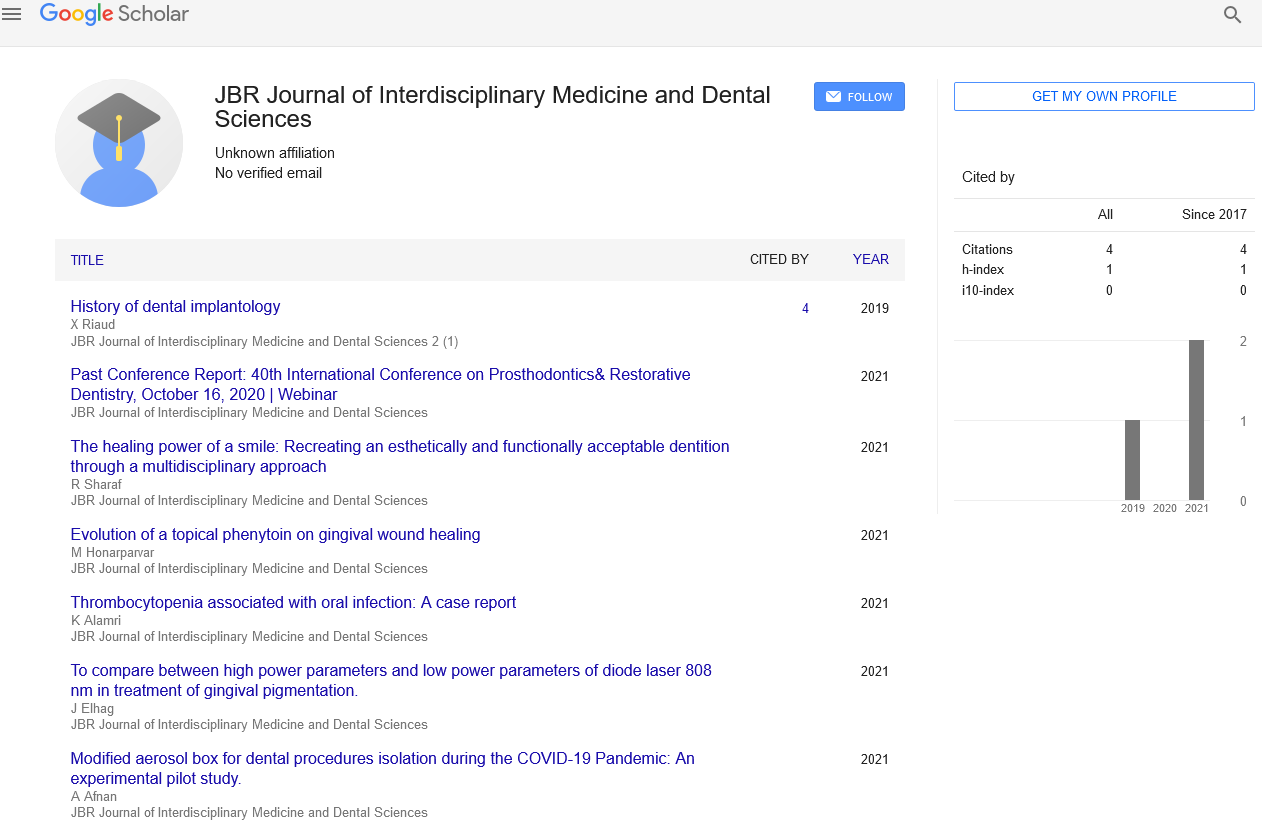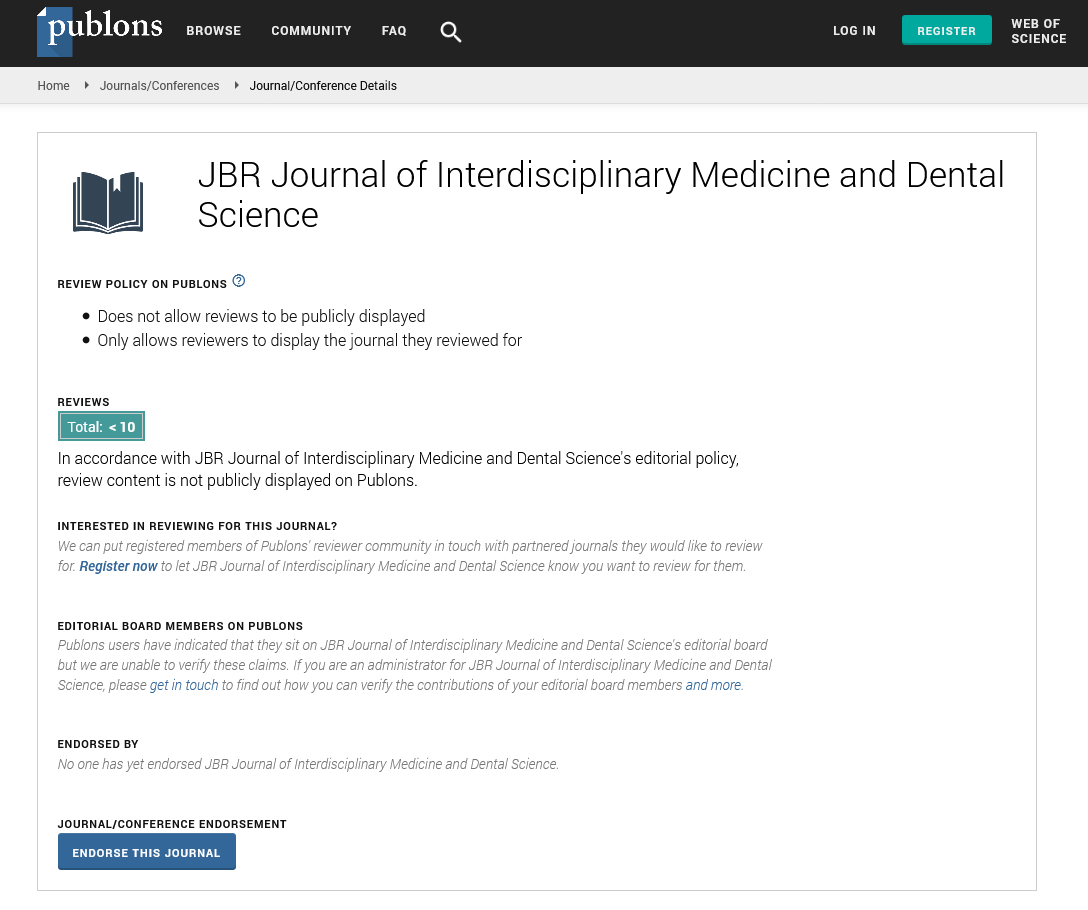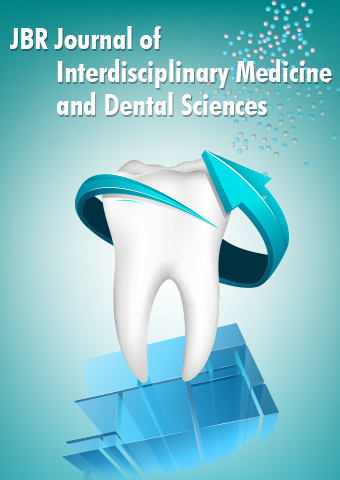Short Communication - JBR Journal of Interdisciplinary Medicine and Dental Sciences (2023) Volume 6, Issue 3
Dental Pathology Understanding Common Oral Health Disorders
Janshon D aniel*
Department of pharmacology, Australia
Department of pharmacology, Australia
E-mail: robert_j66@gmail.com
Received: 01-May-2023, Manuscript No. jimds-23-100126; Editor assigned: 04-May-2023, PreQC No. jimds-23-100126 (PQ); Reviewed: 19-May-2023, QC No. jimds-23-100126; Revised: 24-May-2023, Manuscript No. jimds-23-100126 (R); Published: 30-May-2023, DOI: 10.37532/2376- 032X.2023.6(3).36-38
Abstract
Dental pathology encompasses a wide range of oral health disorders that affect the teeth, gums, and surrounding oral tissues. This article provides an overview of common dental pathologies, their causes, symptoms, and treatment options. Dental caries, or tooth decay, is a prevalent condition caused by bacterial activity and poor oral hygiene. Periodontal disease, characterized by gum infections and bone loss, can lead to tooth loss if left untreated. Oral cancer poses a significant threat to oral health, with symptoms including ulcers, patches, and difficulty swallowing. Temporomandibular joint disorders (TMD) affect the jaw joint and muscles, causing pain and limited movement. Tooth erosion, resulting from acid exposure, leads to tooth sensitivity and discoloration. Regular dental check-ups, good oral hygiene practices, and early detection are essential for prevention and timely treatment of these conditions, ensuring optimal oral health and overall well-being.
Keywords
Dental pathology •Gingivitis • TMJ disorders • Periodontitis • Tooth erosion
Introduction
Dental pathology is a branch of dentistry dedicated to understanding and diagnosing various oral health disorders that affect the teeth, gums, and surrounding oral tissues. These disorders can range from mild conditions to severe diseases that significantly impact a person’s oral health and overall well-being. By gaining a deeper understanding of common oral health disorders, their causes, symptoms, and available treatment options, individuals can take proactive measures to maintain their oral health and seek timely dental care when needed [1]. The field of dental pathology encompasses a wide range of conditions, including dental caries (tooth decay), periodontal disease, oral cancer, Temporomandibular joint disorders (TMD), and tooth erosion. Each of these disorders has unique characteristics, risk factors, and potential complications, making it crucial to familiarize oneself with their manifestations to promote early detection and appropriate management. Dental caries, commonly known as tooth decay or cavities, remains one of the most prevalent dental pathologies worldwide. It occurs when bacteria in the mouth produce acids that gradually erode the tooth enamel, leading to the formation of cavities [2]. Poor oral hygiene practices, a diet high in sugar and carbohydrates, and bacterial activity contribute to the development of dental caries. Early symptoms may include tooth sensitivity, pain, and visible holes or discoloration on the affected teeth. Timely diagnosis and treatment are essential to prevent further damage and preserve the tooth structure. Periodontal disease, another significant oral health disorder, affects the gums and supporting structures of the teeth. Gingivitis, the initial stage of periodontal disease, is characterized by inflamed and bleeding gums. Without appropriate intervention, it can progress to periodontitis, resulting in gum recession, bone loss, and potential tooth loss [3]. Poor oral hygiene, tobacco use, genetic factors, and systemic conditions can increase the risk of periodontal disease. Early detection, along with professional dental care, is crucial to prevent irreversible damage and maintain oral health. Oral cancer is a serious condition that can affect various areas of the oral cavity, including the lips, tongue, cheeks, floor of the mouth, and throat. It often manifests as non-healing ulcers, red or white patches, persistent pain, difficulty swallowing, or the presence of a lump. Oral cancer can be caused by various factors, including tobacco and alcohol use, human papillomavirus (HPV) infection, and prolonged sun exposure. Early detection through routine dental examinations is vital for successful treatment and improved prognosis. Temporomandibular joint disorders (TMD) encompass a group of conditions that affect the jaw joint and associated muscles. Individuals with TMD may experience jaw pain, clicking or popping sounds, difficulty opening or closing the mouth, and headaches. Teeth grinding, jaw misalignment, trauma, or arthritis can contribute to the development of TMD. Proper diagnosis and management, including self-care measures, physical therapy, and, in severe cases, surgical intervention, can alleviate symptoms and improve jaw function. Tooth erosion is a condition characterized by the gradual loss of tooth enamel due to acid exposure [4]. Acidic foods and beverages, frequent vomiting (as seen in eating disorders or acid reflux), and certain medications can contribute to tooth erosion. Symptoms may include tooth sensitivity, discoloration, and rounded or transparent edges. Identifying and addressing the underlying causes, along with lifestyle modifications and dental restorations, can help protect the remaining tooth structure and prevent further erosion. By understanding the common oral health disorders encompassed by dental pathology, individuals can make informed decisions regarding their oral care. Regular dental check-ups, practicing good oral hygiene, adopting a healthy lifestyle, and seeking timely professional care are essential in preventing and managing these conditions. Maintaining optimal oral health contributes not only to a beautiful smile but also to overall wellbeing and quality of life.
Materials and Method
Dental caries (Tooth decay)
Dental caries, commonly known as tooth decay or cavities, is one of the most prevalent dental pathologies. It occurs when bacteria in the mouth produce acids that erode the tooth enamel over time. Poor oral hygiene, a high sugar diet, and bacterial activity contribute to the development of dental caries. Symptoms may include tooth sensitivity, pain, and visible holes or discoloration on the affected teeth. Treatment involves removing the decayed tissue and restoring the tooth with fillings, crowns, or in severe cases, root canal therapy [5].
Periodontal disease
Periodontal disease refers to infections of the gums and supporting structures of the teeth. Gingivitis, the early stage of periodontal disease, is characterized by inflamed and bleeding gums [6]. If left untreated, it can progress to periodontitis, leading to gum recession, bone loss, and eventually tooth loss. Poor oral hygiene, tobacco use, genetic factors, and certain systemic conditions increase the risk of periodontal disease. Treatment involves professional deep cleaning (scaling and root planning), antibiotics, and in advanced cases, surgical intervention may be required.
Oral cancer
Oral cancer is a serious condition that can affect the lips, tongue, cheeks, floor of the mouth, and throat. It often manifests as non-healing ulcers, red or white patches, persistent pain, difficulty swallowing, or a lump in the oral cavity [7]. Risk factors include tobacco and alcohol use, human papillomavirus (HPV) infection, and prolonged sun exposure. Early detection through regular dental examinations is crucial for successful treatment. Treatment options include surgery, radiation therapy, chemotherapy, or a combination of these approaches.
Temporomandibular joint disorders (TMD)
Temporomandibular joint (TMJ) disorders refer to a group of conditions that affect the jaw joint and surrounding muscles. Common symptoms include jaw pain, clicking or popping sounds, difficulty opening or closing the mouth, and headaches [8]. Causes of TMD can include teeth grinding, jaw misalignment, trauma, or arthritis. Treatment options range from self-care measures (rest, ice, avoiding hard foods) to splints, physical therapy, medication, and, in severe cases, surgery [9].
Tooth erosion: Tooth erosion occurs when the tooth enamel gradually wears away due to exposure to acid. Acidic foods and beverages, frequent vomiting (as seen in eating disorders or acid reflux), and certain medications can contribute to tooth erosion. Symptoms include tooth sensitivity, discoloration, and rounded or transparent edges. Treatment involves addressing the underlying cause, modifying diet and habits, and sometimes restoring the affected teeth with fillings or crowns [10].
Discussion
Dental pathology encompasses the study and diagnosis of various oral health disorders that affect the teeth, gums, and surrounding oral tissues. These conditions can range from mild to severe and require proper assessment, treatment, and preventive measures to maintain optimal oral health. This article aims to provide an overview of some common dental pathologies, their causes, symptoms, and available treatment options.
Conclusion
Dental pathology encompasses a wide range of oral health disorders that can significantly impact an individual’s quality of life if left untreated. Understanding common oral health disorders, their causes, symptoms, and available treatment options is crucial for maintaining optimal oral health and overall well-being. Dental caries, periodontal disease, oral cancer, temporomandibular joint disorders (TMD), and tooth erosion are among the key conditions in dental pathology. Timely diagnosis, preventive measures, and appropriate treatment play a vital role in managing these disorders and preventing further complications. Regular dental checkups, practicing good oral hygiene, adopting a healthy lifestyle, and being aware of risk factors associated with these disorders are essential preventive measures. Early detection through routine dental examinations allows for timely intervention and improves treatment outcomes. It is important to emphasize that oral health is not limited to having a beautiful smile. It is closely linked to overall well-being, as oral health disorders can have systemic implications and impact an individual’s quality of life. By taking proactive steps in maintaining oral health, individuals can not only preserve their teeth and gums but also contribute to their overall health and confidence. Dental pathology serves as a guide to understanding common oral health disorders, empowering individuals to take charge of their oral care. By staying informed, seeking professional dental care, and practicing preventive measures, individuals can pave the way for a lifetime of healthy smiles and optimal oral health.
References
- Cambon-Thomsen A, Rial-Sebbag E, Knoppers BM et al. Trends in ethical and legal frameworks for the use of human biobanks. J EUR R. 30, 373-382 (2007).
- Dietrich E, Powell J, Taylor JR et al. Canagliflozin: a novel treatment option for type 2 diabetes. Drug Des Devel Ther. 7, 1399-1408 (2013).
- Pratley RE, McCall T, Fleck PR et al. Alogliptin use in elderly people: a pooled analysis from phase 2 and 3 studies. Am Geriatr Soc. 57, 2011-2019 (2009)?
- Pratley RE, Rosenstock J, Pi-Sunyer FX et al. Management of type 2 diabetes in treatment-naive elderly patients: benefits and risks of vildagliptin monotherapy. Diabetes Care. 30, 3017-3022 (2007).
- Doucet J, Chacra A, Maheux Pet et al. Efficacy and safety of saxagliptin in older patients with type 2 diabetes mellitus. Curr Med Res Opin. 27, 863-869 (2011).
- Amori RE, Lau J, Pittas AG et al. Efficacy and safety of incretin therapy in type 2 diabetes: systematic review and meta-analysis. JAMA. 298, 194-206 (2007).
- Cvetković RS, Plosker GL. Exenatide: a review of its use in patients with type 2 diabetes mellitus (as an adjunct to metformin and/or a sulfonylurea). Drugs. 67, 935-954 (2007).
- Gallwitz B. Exenatide in type 2 diabetes: treatment effects in clinical studies and animal study data. Int J Clin Pract. 60, 1654-1661 (2006).
- Briones M, Bajaj M. Exenatide: a GLP-1 receptor agonist as novel therapy for Type 2 diabetes mellitus. Expert Opin Pharmacother. 7, 1055-1064 (2006).
- Verdonck LF, Sangster B, van Heijst AN et al. Buformin concentrations in a case of fatal lactic acidosis. Diabetologia. 20, 45-46 (1981).
Indexed at, Google Scholar, Crossref
Indexed at, Google Scholar, Crossref
Indexed at, Google Scholar, Crossref
Indexed at, Google Scholar, Crossref
Indexed at, Google Scholar, Crossref
Indexed at, Google Scholar, Crossref
Indexed at, Google Scholar, Crossref
Indexed at, Google Scholar, Crossref
Indexed at, Google Scholar, Crossref


